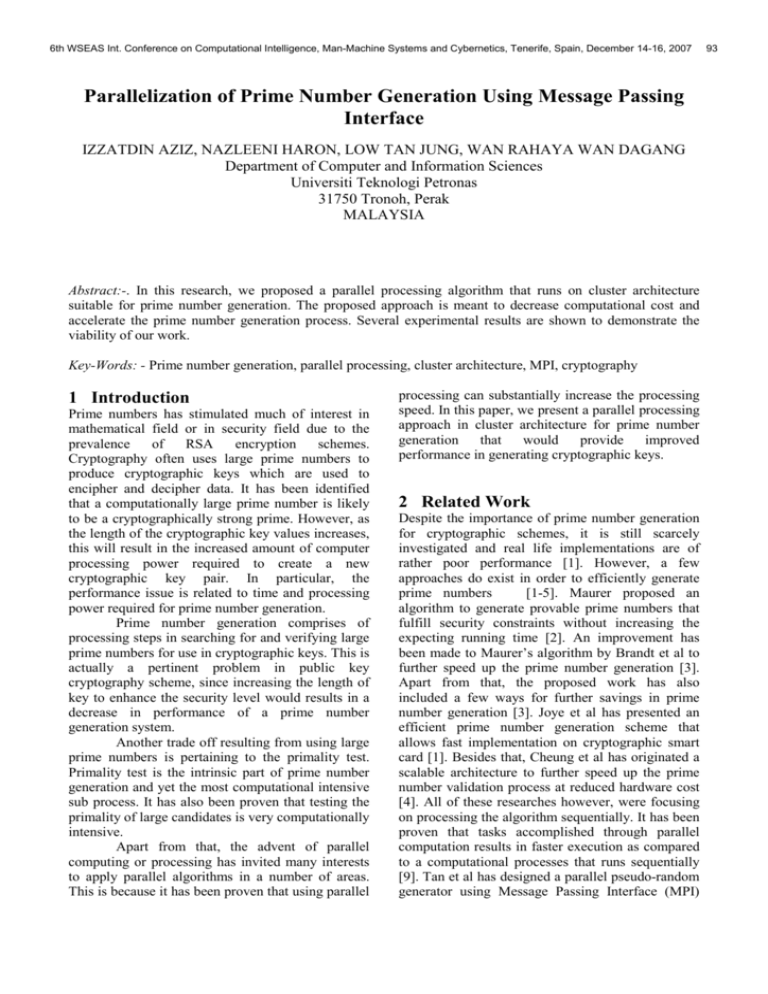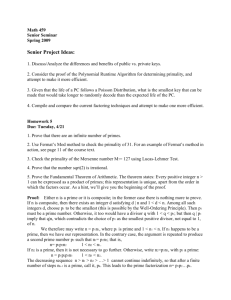Parallelization of Prime Number Generation Using Message
advertisement

6th WSEAS Int. Conference on Computational Intelligence, Man-Machine Systems and Cybernetics, Tenerife, Spain, December 14-16, 2007
Parallelization of Prime Number Generation Using Message Passing
Interface
IZZATDIN AZIZ, NAZLEENI HARON, LOW TAN JUNG, WAN RAHAYA WAN DAGANG
Department of Computer and Information Sciences
Universiti Teknologi Petronas
31750 Tronoh, Perak
MALAYSIA
{izzatdin, nazleeni, lowtanjung}@petronas.com.my, wan.rahaya@gmail.com
Abstract:-. In this research, we proposed a parallel processing algorithm that runs on cluster architecture
suitable for prime number generation. The proposed approach is meant to decrease computational cost and
accelerate the prime number generation process. Several experimental results are shown to demonstrate the
viability of our work.
Key-Words: - Prime number generation, parallel processing, cluster architecture, MPI, cryptography
1 Introduction
Prime numbers has stimulated much of interest in
mathematical field or in security field due to the
prevalence
of
RSA
encryption
schemes.
Cryptography often uses large prime numbers to
produce cryptographic keys which are used to
encipher and decipher data. It has been identified
that a computationally large prime number is likely
to be a cryptographically strong prime. However, as
the length of the cryptographic key values increases,
this will result in the increased amount of computer
processing power required to create a new
cryptographic key pair. In particular, the
performance issue is related to time and processing
power required for prime number generation.
Prime number generation comprises of
processing steps in searching for and verifying large
prime numbers for use in cryptographic keys. This is
actually a pertinent problem in public key
cryptography scheme, since increasing the length of
key to enhance the security level would results in a
decrease in performance of a prime number
generation system.
Another trade off resulting from using large
prime numbers is pertaining to the primality test.
Primality test is the intrinsic part of prime number
generation and yet the most computational intensive
sub process. It has also been proven that testing the
primality of large candidates is very computationally
intensive.
Apart from that, the advent of parallel
computing or processing has invited many interests
to apply parallel algorithms in a number of areas.
This is because it has been proven that using parallel
processing can substantially increase the processing
speed. In this paper, we present a parallel processing
approach in cluster architecture for prime number
generation
that
would
provide
improved
performance in generating cryptographic keys.
2 Related Work
Despite the importance of prime number generation
for cryptographic schemes, it is still scarcely
investigated and real life implementations are of
rather poor performance [1]. However, a few
approaches do exist in order to efficiently generate
prime numbers
[1-5]. Maurer proposed an
algorithm to generate provable prime numbers that
fulfill security constraints without increasing the
expecting running time [2]. An improvement has
been made to Maurer’s algorithm by Brandt et al to
further speed up the prime number generation [3].
Apart from that, the proposed work has also
included a few ways for further savings in prime
number generation [3]. Joye et al has presented an
efficient prime number generation scheme that
allows fast implementation on cryptographic smart
card [1]. Besides that, Cheung et al has originated a
scalable architecture to further speed up the prime
number validation process at reduced hardware cost
[4]. All of these researches however, were focusing
on processing the algorithm sequentially. It has been
proven that tasks accomplished through parallel
computation results in faster execution as compared
to a computational processes that runs sequentially
[9]. Tan et al has designed a parallel pseudo-random
generator using Message Passing Interface (MPI)
93
6th WSEAS Int. Conference on Computational Intelligence, Man-Machine Systems and Cybernetics, Tenerife, Spain, December 14-16, 2007
[5]. This work is almost similar to ours but with
different emphasis. The prime numbers generated
are to be used for Monte Carlo simulations and not
cryptography. Furthermore, considerable progresses
have been made in order to develop highperformance asymmetric key cryptography schemes
using approaches such as the use of high-end
computing hardware [6, 7, and 8].
3 System Model
3.1 Experimental Setup
The experimental cluster platform for performance
comprised of 20 SGI machines. Each of the
machines consists of off-the-shelf Intel i386 based
dual P3-733MHz processors with 512MB memory
Silicon Graphics 330 Visual Workstations. These
machines are connected to a Fast Ethernet 100Mbps
switch. The head node performs as master node with
multiple network interfaces [10]. Although these
machines are considered to be superseded in terms
of hardware and performance as compared to the
latest version of high performance computers,
what’s important in this research is the
parallelization of the algorithm and how jobs are
disseminated among processors.
initialize the first row of the table only.
Fig.1 Master creates a dynamic 2D
array to be populated with odd numbers
The parallel segment begins when master
node broadcasts the row[0] to all nodes by using
MPI_Bcast. This row[0] will be used by each node
to continue populating the rest of the rows of the
table with odd numbers. Master node will then
equally divide n-1 number of rows left that is yet to
be populated by number of nodes available in the
grid cluster. Each node will be given an equal
number of rows to be populated with odd numbers.
This could be achieved by using MPI_Send. A
visual representation of this idea is depicted in Fig.2.
3.2 Number Generation
In order to first generate the number, a random seed
is picked and input into the program. The choice of
seed is crucial to the success of this generator as it
has to be as random as possible. Otherwise anyone
who uses the same random function would be
capable of generating the primes, thus beats the
purpose of having strong primes.
3.3 Primality Test
We have selected trial division algorithm as the core
for primality testing. This algorithm is based on a
given composite integer n, trial division consists of
trial-dividing n by every prime number less than or
equal to n . If a number is found which divides
evenly into n, that number is a factor of n.
3.4 Parallel Approach
Once a random number have been generated, master
node will create a table of dynamic 2D array, which
later will be populated with odd numbers. As shown
in Fig.1, a pointer-to-pointer variable **table in
master, will points to an array of pointers that
subsequently points to a number of rows. This will
result in a table of dynamic 2D array. After the table
of dynamic 2D array is created, master will then
Fig.2. Master sends an equal size of
row to each slave
Each node will receive n numbers of rows to be
populated with odd numbers. This is where the
parallel process takes place. Each node will process
each row given concurrently. Each node will first
populate the rows with odd numbers. Then they will
filter out for prime numbers using the primality test
chosen. The odd prime numbers will remain in the
rows but those that are not will be assigned to
NULL. Each populated row are then returned to
master node, whom then randomly pick for three
distinct primes for the value of p,q, and public key e
of the cryptographic scheme.
For an example, if there are 4 processors
available to execute the above tasks, and there are
1200 rows need to be populated with prime
numbers, each slave will be given 300 rows to be
94
6th WSEAS Int. Conference on Computational Intelligence, Man-Machine Systems and Cybernetics, Tenerife, Spain, December 14-16, 2007
processed. The overall procedure is depicted in
Fig.3.
Master receives populated rows from
each slave.
Master checks unpopulated rows
If maxRow > 0
Master sends unpopulated row
to slave
Master picks prime numbers randomly
Prompt to select program option
Switch (method)
Case
1:
prompt
to
enter
a
value greater than 10000
If value > 10000, generate key
primes
Fig.3.Example of assigning 1200 rows
to 4 processors (slaves)
Processor 0 will process row(1) up to
row(299), processor 1 will be processing row(300)
up to row(599), processor 2 will be processing
row(600) up to row(899) and lastly processor 3 will
be processing row(900) up to the last row,
row(1199).
After each node returns the populated rows
to master node, it will then pick randomly prime
numbers to be assigned as the value of p, q, and e.
These values can later be used for encryption and
decryption part of a cryptosystem algorithm. It is to
be reminded that the parallel process that takes place
in the whole program is only on the prime number
generation.
4 Parallel Algorithm
The algorithm of the parallel program is as follows:
Start
Else, Exit program
Case 3: open file and decrypt
Case 4: exit program
End
End
5 Evaluation
Table 1, shows the execution time of
running the parallel program on single and more
computing nodes. From the results, it can be inferred
that running the algorithm in parallel mode has
accelerated the prime number generation process.
However, it seems like there is a noticeable increase
in processing time when the program is running
more than 3 nodes. The execution time has recorded
to be higher when more nodes participated in the
generation process. This may be caused by the
network latency during the distribution of the tasks,
which leads to the increased of execution time taken
for the communication between nodes.
Master creates a table of odd numbers and
initialized row [0] only
Master broadcasts row [0] to all slaves
Master sends a number of rows to each slave
Each slave will receive an initialized
row from master
Each slave will populate row prime
numbers
Each slave will return populated row to
Master
Master waits for results from slaves
Table 1: Comparison of Execution
Time for Different Number of Nodes.
Number of nodes
Execution Time (ms)
1
7.850
3
0.039
5
0.043
10
0.053
30
0.093
Fig.4 shows the performance measurement
using MPI_GATHER tested on 15 nodes. This
figure was captured using the MPICH Jumpshot4
tool to evaluate the algorithm usage of MPI libraries.
The numbers plotted shows the amount of time
95
6th WSEAS Int. Conference on Computational Intelligence, Man-Machine Systems and Cybernetics, Tenerife, Spain, December 14-16, 2007
taken for each node to send back the prime numbers
discovered back to the master node.
0 .0 2 47
10 11 12 13 14 15 16
0.0 2 5 4
9
0 .02 5 3
8
0.0 2 7 3
7
0 .0 2 6 4
6
0 .0 3 0 3
5
0.03
0.0 2 7 3
4
0 .0 3 18
3
0.035
0.0 2 9 3
0 .0 35 4
0.04
0.0 3 2 5
0 .0 3 8 5
0.045
0 .0 3 59
Time (Seconds)
0.02
0.015
0 .0 1 37
0.0 1 42
0.025
0.01
0
0.005
0
1
2
Node
Fig.4. Time taken for MPI_BCAST and
MPI_GATHER running on 15 nodes.
From the figure, it is observed that the algorithm
gather was massive for the first node and
deteriorated as it approached the last node. This may
due to the frequent prime numbers discovered at the
beginning of the number series and becomes scarce
as the numbers becomes larger towards the end. This
will prove that the relative frequency of occurrence
of prime numbers decreases with size of the number
which result in lesser prime numbers were sent back
to master node by later nodes.
6 Conclusion
We have proposed a parallel approach for prime
number generation in order to accelerate the process.
The parallelism and the cluster architecture of this
approach have been tested with large prime
numbers. Results have demonstrated that
improvement can be obtained if parallel approach is
deployed. However, further improvements can be
made that include:
(1) Use other primality test that is more significant
or feasible for large prime number generation such
as Rabin-Miller algorithm.
(2) Use other random number generation that can
produce random numbers with less computation yet
provides higher security level.
References:
[1] M. Joye, P. Paillier and S. Vaudenay,
Efficient Generation of Prime Numbers,
Cryptographic Hardware and Embedded
Systems, vol. 1965 of Lecture Notes in
Computer Science, pp. 340-354, SpringerVerlag, 2000.
[2]
Maurer, Fast Generation of Prime Numbers
and Secure Public-Key Cryptographic
Parameters, Journal of Cryptology, vol.8 no.3
(1995), 123-156.
[3] J.Brandt, I. Damgard, and P. Landrock.
Speeding up prime number generation. In
Advances in Cryptology -- ASIACRYPT '91,
vol. 739 of Lecture Notes in Computer
Science, pp. 440--449, Springer-Verlag,
1991.
[4] Cheung, R.C.C., Brown, A., Luk, W.,
Cheung, P.Y.K., A Scalable Hardware
Architecture for Prime Number Validation,
IEEE International Conference on FieldProgrammable Technology, 2004. pp. 177184, 6-8 Dec. 2004.
[5] Tan, C. J. and Blais, J. A. PLFG: A Highly
Scalable Parallel Pseudo-random Number
Generator for Monte Carlo Simulations. 8th
international
Conference
on
HighPerformance Computing and Networking
(May 08 - 10, 2000). Lecture Notes In
Computer Science, vol. 1823. SpringerVerlag, London, 127-135.
[6] Agus Setiawan, David Adiutama, Julius
Liman, Akshay Luther and Rajkumar Buyya,
GridCrypt : High Performance Symmetric
Key Cryptography using Enteprise Grids. 5th
International Conference on Parallel and
Distributed Computing, Applications and
Technologies (PDCAT 200) , Singapore.
Springer Verlag Publications (LNCS Series),
Berlin, Germany. December 8-10, 2004.
[7] Praveen Dongara, T. N. Vijaykumar,
Accelerating Private-key cryptography via
Multithreading
on
Symmetric
Multiprocessors. In Proceedings of the IEEE
International Symposium on Performance
Analysis of Systems and Software (ISPASS),
March 2003.
[8] Jerome Burke, John McDonald, Todd
Austin, Architectural Support for Fast
Symmetric-Key Cryptography. Proc. ACM
Ninth Int'l Conf. Architectural Support for
Programming Languages and Operating
Systems (ASPLOS-IX), Nov. 2000.
[9] Selim G Aki, Stefan D Bruda, Improving A
Solution's
Quality
Through
Parallel
Processing. The Journal of Supercomputing
archive.Volume 19 , Issue 2 (June 2001).
96
6th WSEAS Int. Conference on Computational Intelligence, Man-Machine Systems and Cybernetics, Tenerife, Spain, December 14-16, 2007
[10]
Dani Adhipta, Izzatdin Bin Abdul Aziz,
Low Tan Jung, Nazleeni Binti Haron
.Performance Evaluation on Hybrid Cluster:
The Integration of Beowulf and Single
System Image, The 2nd Information and
Communication
Technology
Seminar
(ICTS),Jakarta. August 2006.
97








